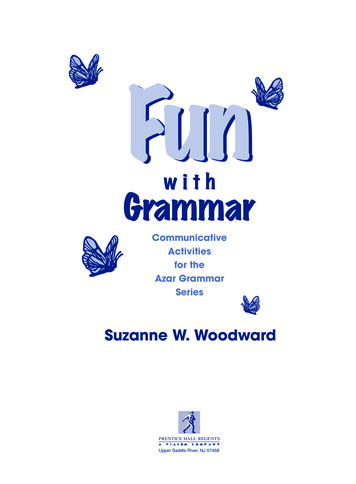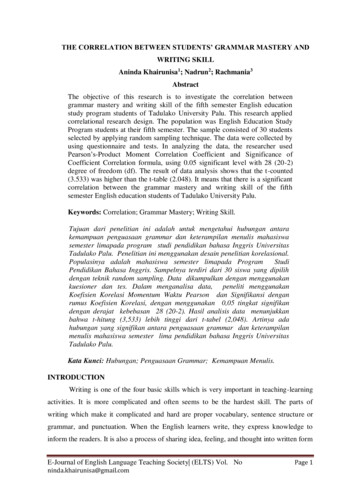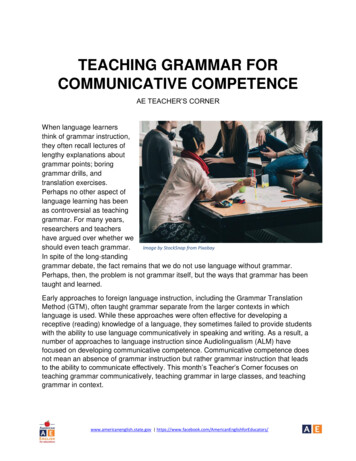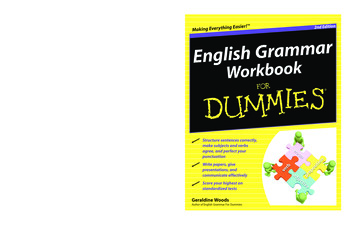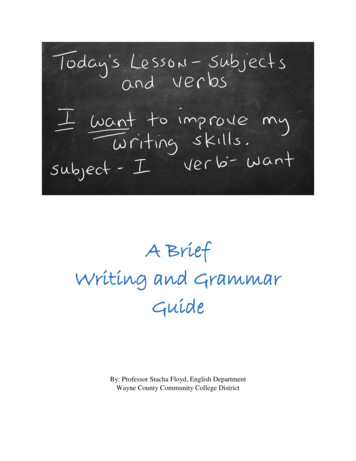
Transcription
A BriefWriting and GrammarGuideBy: Professor Stacha Floyd, English DepartmentWayne County Community College District
Table of ContentsIntroduction . 1Essays . 2Practice Essay . 9Fragments . 14Run-ons and Comma Splices . 17Subject-verb Agreement . 22Pronouns . 27Agreement . 27Reference and Ambiguity . 28Consistency . 29Pronoun Case . 30Commas . 33Commas with Introductory Elements . 33Commas with Nonessential Interrupters . 33Commas with Items in a Series . 34Commas before Coordinating Conjunctions . 35Commas with Quotation Marks . 35Commas with Everyday Material . 36Apostrophes . 38Other Important Tips . 40Answer Key . 42Additional Resources . 48References . 49ii
IntroductionStudents have often said that English has never been their subject. Theyhave struggled in their writing classes because it has so many rules thatare hard to remember. Students have also stated that they do not knowwhy they have to take English classes because they are going to be anurse, engineer, or mechanic. What these students fail to realize is thattheir attitudes affect their perception of English. Admittedly, in order towrite well, students must learn a lot of rules, but the more they practicethe rules in their everyday lives—at home and work, in their textmessages and social media posts, as well as in conversations with familyand friends—the easier it will be to learn them. They will even begin tosee how they can use these rules when writing a resume and cover letter,a report on a patient or project, and a letter to a teacher about theirchildren or a company about a product or service with which they arenot satisfied.In this Brief Writing and Grammar Guide, you will learn how to write aneffective essays and identify as well as correct some common grammarmistakes. A description, some examples, and practice exercises alongwith an answer key for them will be provided on each topic. While thisguide will not teach you everything about English, it will help you tostrengthen your writing skills.1
EssaysAn essay is a group of related paragraphs developing one main idea,which is a thesis sentence. A standard essay is typically five paragraphslong, consisting of an introduction paragraph, three body paragraphs,and conclusion paragraph. While an essay can be longer or shorterdepending upon the topic and assignment guidelines, it should have atleast three paragraphs in order to have one paragraph for each requiredpart—the introduction, body, and conclusion.Sometimes students confuse an essay with a paragraph. However, assuggested above, paragraphs make up essays. Paragraphs are a group ofrelated sentences that develop a main idea known as the topic sentence.Some have been taught that a paragraph is three to five sentences, but towrite an effective paragraph, you should make a paragraph as long as itneeds to be in order to provide support for your main idea or point.Instructors do not count the number of sentences or words, for thatmatter, to determine your grade. We evaluate how well you have provenyour point.Each paragraph within the essay works to develop your thesis. Youressay should begin with an introduction. Its purpose is to grab yourreader’s attention, introduce your topic, and present your thesis. It caninclude a plan of development, which indicates what ideas you will useto support your thesis and the order in which they will be presented. Thenext section of your essay is the body. Each paragraph in the bodydevelops an aspect of your thesis. The topic sentence indicates what partof the thesis will be explained in that paragraph as well as what the pointof that paragraph is. The conclusion paragraph restates your thesis indifferent words and brings the point of your essay and its support to aclose. It does not introduce new ideas or develop your thesis.2
Below are examples of poor and good introduction and conclusionparagraphs. An explanation of what makes the introduction andconclusion poor is provided in italics. An example of an entire essaywill be provided later.Poor Introduction:I came to college for several reasons. First, I want to improve mylife. Second, I want to be able to provide for my family. Finally, I wantto accomplish my dream of becoming a nurse.This introduction is poor because it is only a summary of the points thatwill be discussed in the body of the essay. Why should the reader readfurther if you give everything away in the first paragraph? You shouldalways aim to grab the reader’s interest. Make him or her want to readfurther. Do not give away too much in the beginning.Good Introduction:People come to college for many reasons. Some come to collegebecause their parents made them. Their parents have given them theultimatum either to go to school, get a job, or move out of their house.In other words, they really do not want to go but attend just to maketheir parents happy. Others come because they have nothing else to do.Perhaps they are a stay-at-home mom or a recent retiree. They come tofill their days with something to do besides watching television or tohave some other adults with whom to share ideas. They want to keeptheir minds stimulated. Unfortunately, some have come because theyhave been laid off from their jobs and have to start a new career. Theyhave tried to get a new job but have reached stumbling blocks because ofa lack of education. I, on the other hand, have come to college toimprove my life, to provide for my family, and to accomplish my dream.3
Poor Conclusion:These are the reasons why I came to college. I want to improvemy life, I want to provide for my family, and I want to accomplish mydream of becoming a nurse.This conclusion is poor because it is only a summary of the points thathave been discussed in the body of the essay. You have already saidthis. Why should the reader bother with reading these same ideasagain? Often, students will use the poor introduction above and thispoor conclusion in the same essay. Always try to avoid repetition. Youshould always aim to hold the reader’s interest all the way to the end ofyour essay. Make him or her want to read to the very end. Do notmerely summarize the supporting points you made in the body; tie thoseideas together and bring your essay to a close.Good Conclusion:Basically, my three reasons for coming to college all stem from mydesire to secure a wonderful future for my family and me. Eventually, Irealized that my high school diploma and job at the department storewere not going to be enough to live the life that I wanted for us. Since Iwanted more, I needed to strive for more. With the way the economyand our society are today, I can only accomplish my goals to improvemy life, to provide for my family, and to become a nurse if I go back tocollege and get a degree. These reasons were not only the motivation Ineeded to go back to college, but they will also be the inspiration I needto succeed in college and in life.The thesis is the most important sentence in your paper because asindicated above, it indicates the point of your essay. Typically, it comesat the end of the introduction paragraph. Experienced writers can placetheir thesis in other places in the introduction or actually use an impliedthesis, but until you have mastered the rules, you should follow them.4
Include a title for your paper. It should indicate the topic of your essay.The first letter of all major words in your title should be capitalized.You do not need to capitalize articles and prepositions unless they are atthe beginning or end of the title. Also, if you have a title and subtitle,use a colon between the two and capitalize the first word of the subtitleno matter what word it is. Finally, do not include a period at the end ofthe title since it is not a sentence.According to John Langan, a well-known and respected Englishtextbook author, a writing should have unity, support, coherence, andsentence skills. He calls these the four bases of effective writing. Unityis making sure all of the paragraphs within an essay and all of thesentences within a paragraph develop one main idea—the thesisstatement in an essay and the topic sentence of a paragraph. Also,support is making sure the sentences throughout your essay provideplenty of specific evidence to support your main idea. In addition,coherence is using transition words, phrases, and/or sentences to create aflow between the sentences and paragraphs. Finally, sentence skillsrefer to following the grammar and punctuation rules (Langan xviii, 49).To understand all of the information that you have just read, look at theexample essay below.Example EssayWhy I Came to CollegePeople come to college for many reasons. Some come to collegebecause their parents made them. Their parents have given them theultimatum either to go to school, get a job, or move out of their house.In other words, they really do not want to go but attend just to maketheir parents happy. Others come because they have nothing else to do.Perhaps they are a stay-at-home mom or a recent retiree. They come to5
fill their days with something to do besides watching television or tohave some other adults with whom to share ideas. They want to keeptheir minds stimulated. Unfortunately, some have come because theyhave been laid off from their jobs and have to start a new career. Theyhave tried to get a new job but have reached stumbling blocks because ofa lack of education. I, on the other hand, have come to college toimprove my life, to provide for my family, and to accomplish mydream.Due to some unfortunate circumstances that my familyexperienced in the past, I came to college to make my life better. Myparents struggled to provide for us. My dad had to drop out of highschool in order to help take care of his family after his father passed, sohe had a hard time finding a job that paid above minimum wage. Mymom and dad got married while they were still young. Therefore,college was not an option for her because my mom began working tohelp him. However, she was limited in the number of hours she couldwork since she had to be home to take care of my siblings and me, forthey did not have the money for a babysitter. Because of theirexperiences, my parents always stressed as we were growing up that mybrother, sister, and I must attend college. They explained that theirinability to get a good job was due in part to their lack of education.However, when I graduated from high school, college initially was notan option since my parents could not afford to pay for it, and as theoldest of my siblings, I wanted to help my parents support our family,especially after my mom found out she had cancer and could not helpprovide for the family for a while. Although I could not go to collegefor several years, my family’s experiences caused my desire for a highereducation to remain in the forefront of my mind. Therefore, as soon as Icould afford to attend college, I signed up, for I wanted more for myfuture than my parents, siblings, and I had in our past.I also came to college to be able to take care of my own children. Ihave been blessed with two beautiful little girls who seem to need6
something new every day, not to mention everything they want. As theirmother, I am responsible for providing food, clothes, and shelter. Whenwe go to the store, they ask for Barbie dolls, Easy Bake ovens, NintendoDS, and other things they see their friends have. Sure my job at themajor department store helps me to provide their needs, but we cannotdo much else. I am living paycheck to paycheck. At times, I have hadto ask for help from family members and friends. While I appreciate thehelp that they willingly give, I do not want to live that way. I want to beable to give my daughters not only their basic needs but also some oftheir desires. I want to be able to take them on trips and be able topurchase things for them without worrying if I will have enough for rent.One way that I can do that is to obtain an education to get a job that paysmore. Most well-paying jobs require a degree, so I must get one.Finally, due to the help that my mother and family received whileshe fought cancer, I want to be a nurse, and attending college will helpme to reach this goal. My mother really had a difficult experience as shebattled with cancer, but the nurses at the hospital helped to keep herfighting. In addition to taking her vitals and administering themedication, they always knew the right words to say when she was sickfrom the chemotherapy and radiation. They were there to comfort herwhen she gave in to her fear, disappointment, and anger. They wipedher tears when she could not hide them anymore. My mother’s nurseswere there for my siblings and me as well. We were very scared that ourmother was not going to make it and that the cancer would win, but theyheld our hands. They reassured us that the strong fighter we knew as ourmother was the same person fighting cancer. Those nurses reallyhelped my family during that difficult time, and I want to do the samefor other families. I want to work in an oncology department at the samehospital my mother went to, so I can provide support and reassurance.However, of course, I can only become a nurse if I receive a degree.Basically, my three reasons for coming to college all stem from mydesire to secure a wonderful future for my family and me. Eventually, I7
realized that my high school diploma and job at the department storewere not going to be enough to live the life that I wanted for us. Since Iwanted more, I needed to strive for more. With the way the economyand our society are today, I can only accomplish my goals to improvemy life, to provide for my family, and to become a nurse if I go back tocollege and get a degree. These reasons were not only the motivation Ineeded to go back to college, but they will also be the inspiration I needto succeed in college and in life.Notice how this essay accomplishes the four bases that Langanidentified. First, the entire essay discusses why the writer came tocollege, which is the main idea or point, and each paragraph focuses onexplaining one of those reasons, which are expressed in the topicsentences of the body paragraphs. (The thesis is in boldface print, andthe topic sentences are underlined.) Second, each of the paragraphsprovide specific examples explaining the reason. The words are notvague and cannot be understood in a number of different ways. Thereader knows exactly what the writer means. You may claim that theessay seems too long, bur remember that your purpose is to make aconvincing point that the reader can understand. Furthermore, as acollege student, you will be expected to write essays that are ten or sopages long. You will need to develop your thoughts into lengthyparagraphs that make up your essay. Third, each paragraph begins witha transition word, and they are also used within the paragraph, so thereader knows how the paragraphs and sentences relate to each other.(The transition words are italicized.) Finally, the essay does not havefragments, run-ons, and comma splices. It does not have problems withsubject-verb agreement, pronoun agreement and references,capitalization, and punctuation. In other words, it demonstrates strongsentence skills.8
Practice EssayTo help you understand how to write an essay, follow the steps belowand fill in missing information as we go along on a separate sheet ofpaper.Step 1: To begin your writing, you must decide what topic you willfocus on in your essay. You may be given one by your instructor orhave been allowed to choose your own. If it is the former, make sureyou discuss the topic you have been given, and do not change it tosomething else without first discussing it with your instructor. If it islatter, make sure you choose a topic that you know at least a little aboutand one in which you are interested.Step 2: Now, you have to develop a tentative thesis statement. Thisthesis is called “tentative” because you can revise it, making it better andstronger, as you continue to work on your paper; however, you musthave at least a tentative thesis to keep you as well as your essay focused.Your thesis should clearly indicate the topic of your paper and the pointyou will make about it. The thesis should be broad enough to indicatethe point of the entire essay yet specific enough to only indicate whatyou discuss. Furthermore, the length of your essay will also determinehow specific it should be. If you have to write a paper on animalhabitats but the essay is only five hundred words, your topic and thesisshould probably only discuss one animal’s habitat. However, if youressay must be at least five pages, you should probably talk about a fewanimals’ habitats.The way the directions or topic is worded may guide you to the type ofthesis you should use. For example, it may require a certain mode ofdevelopment, such as cause and effect, comparison and contrast, orargumentative. Or you may be able to choose your own direction for thetopic. If that is the case, consider using one of the modes of9
development. Perhaps the one that is used most in college isargumentative, in which you indicate your position on the subject.With all of this information in mind, what will your tentative thesis be?Tentative thesis:Step 3: Once you have a thesis, you must provide support for that thesis.For instance, what reason(s) do you have for the position you are taking?(This guide will follow the standard five paragraph essay, which willrequire you to think of three reasons you feel the way you do.)Reason 1:Reason 2:Reason 3:Step 4: Now that we have your topic, your tentative thesis, and reasonsto use to support your argument, let us develop your supportingparagraphs. You should take the three reasons that you mentionedabove and explain them more thoroughly. The format below is just oneexample of how you can do it. The important thing to keep in mind10
whether you use this format or a different one is that you must provideevidence to support your thesis as well as your topic sentences, usingexamples showing how you reached the position that you havementioned in your thesis. (Keep in mind that you should develop eachpart of your thesis within a paragraph.)Tentative Thesis:I. Topic Sentence Body Paragraph 1:A. Support 1ExplanationB. Support 2ExplanationC. Support 3Explanation11
II. Topic Sentence Body Paragraph 2:A. Support 1ExplanationB. Support 2ExplanationC. Support 3ExplanationIII.Topic Sentence Body Paragraph 3:A. Support 1ExplanationB. Support 2Explanation12
C. Support 3ExplanationAfter you have the thesis and supporting paragraphs for your essay, youcan write your introduction and conclusion paragraphs. Follow theexamples above in the section titled Essays to help you develop a strongintroduction and conclusion for your essay.13
FragmentsIn order for a group of words to be considered a complete sentence, itmust contain a subject, complete verb, and a complete or independentthought. If the group of words is missing just one of the three, it isconsidered a fragment. It is not based upon how short the group ofwords is. For instance, I quit is considered a sentence even though it isonly two words because it has the three required components.Complete SentencesCasey went to Charlotte, NC, for her family reunion.She met her great aunt, her grandmother’s oldest sister, for the first time.Casey plans to visit Charlotte again next summer, so she can spend moretime getting to know her family.FragmentsShe been to the city before. (This group of words is missing a completeverb. The word "been" needs a helping verb.)But did not remember it since she was two at the time. (This group ofwords is missing a subject. The reader does not know who is performingthe action in the sentence. Although these sentences are all related toeach other referring to the same person and trip, each group of wordsmust provide its own subject, complete verb, and complete thought.)When she goes back. She will take a tour of the city as well. (The firstgroup of words is missing a complete thought. It has a subject—she—a14
complete verb—goes—but the words cannot stand on their own as acomplete thought. They need to be joined to the group of words afterthem in order to finish their thought.)Helpful Tip: Some students find it easier to determine if a group ofwords is a sentence or fragment by reading their essays backwards. Inother words, start with the last sentence and read it. Then, read thesecond from last sentence. Next, read the third from last sentence, andso on. By reading them backwards, the groups of words will not flow aseasily, making a fragment seem as if it is correct when it is not. Anotherhelpful trick is to read each sentence separately. For example, read thefirst sentence, and ask yourself does it have the three essential partsbefore reading the next sentence. Pausing between sentences will alsoprevent fragments from hiding within the flow. This will take more ofyour time, but the “A” that you will receive on your essay will make theextra effort worth it.Exercise 1Directions: Read each sentence, and decide whether it is a completesentence or a fragment.Sasha and Chris went on vacation to Washington, DC. After getting restfrom the long bus ride. They went to see the White House. They hopingto get a glimpse of the president. Next, they went to see the Civil WarMonument. They looked for the plaque with the names of the soldierswho were represented in the movie Glory with Denzel Washington.They also saw several museums. For example, the SmithsonianNational Museum of Natural History, the Smithsonian National Museumof African American History, and the Smithsonian National Air andSpace Museum. Next was the Martin Luther King Jr. Monument. The15
most moving monument that they saw. The entire trip was veryeducational.Correcting FragmentsTo correct fragments, you basically have two options. First, you canjoin the group of words to the sentence before or after it. Second, youcan give the group of words whatever it is missing. For instance, let uslook at the example fragments above.Since the first group of words is missing the helping verb, I can give itthe helping verb to fix it.She has been to the city before.Since the second group of words is missing a subject, I can give it asubject to fix it.But she did not remember it since she was two at the time.Since the first group of words in the last fragment example is missing acomplete thought, I can join it to the sentence after it and add a commato fix it.When she goes back, she will take a tour of the city as well.Now that you know how to correct fragments, correct the fragments thatyou found in Exercise 1.16
Run-ons and Comma SplicesWhen you are writing, you have to make sure you join sentencestogether in the right way. Otherwise, you may have a run-on or commasplice. Some students believe that they have a run-on because a groupof words is so long, but a run-on is not determined by the length. Forinstance, look at this group.Although I wanted to go to the beach on Saturday to take in the sun andspend precious time with my family after being on a business trip out oftown for the past month.The group of words above is very long, but believe it or not, it is not arun-on but a fragment. A run-on occurs when you join two completesentences together as if they are one without the proper punctuation orconjunction. On the other hand, a comma splice occurs when you jointwo complete sentences together with only a comma, but a comma is notstrong enough by itself to do that. Run-ons and comma splices arebasically the same mistake. The only difference between the two is acomma as demonstrated in the examples below.Run-onsThomas wants to buy a new car his dream is a BMW.It will remain a dream he is still an unemployed student in high school.Comma SplicesThomas wants to buy a new car, his dream is a BMW.17
It will remain a dream, he is still an unemployed student in high school.Helpful Tip: Comma splices are easier to identify than run-ons becauseyou have something to look for—a comma. However, keep in mind thatevery comma does not signify a comma splice. A lot of times, a commais probably used correctly. Therefore, look for the comma, but then askyourself if you have a sentence in front of it and a separate sentence afterit but no conjunction.Exercise 2Directions: Read each sentence and determine if it is a run-on or commasplice.1. Mrs. Smith's pre-k class has a very interesting group of students init.2. Sarah loves to wear pretty dresses when she goes to school.3. However, her dresses are not conducive to playing outside atrecess she likes to play on the monkey bars.4. Donovan does not like sitting at the table with other students, hecomplains that they are always looking at him.5. Giselle is a social butterfly; no matter whom she sits next to sheloves to talk to them.6. Sydney does not play well with others she does not like to sharethe toys.7. Jacob is such a sweet little boy because he always wants to help histeacher and classmates.8. Even though Christopher struggled with reading at the beginningof the school year, he is excelling now.9. Cody always wants help with putting puzzles together, he nevertries to do them on his own.18
10. Kristian loves to talk about animals, he responds to questions bymaking animal sounds.Correcting Run-ons and Comma SplicesYou have five options for correcting run-ons and comma splices: period,coordination, subordination, semicolon, and conjunctive adverb. Eithermethod of correction can be used; no rule exists that says you have touse one method over another in certain situations. However, in order tokeep your writing interesting, you should use a variety of these methodsin your essay.Period: Separate the run-on or comma splice into two sentences with aperiod.Thomas wants to buy a new car. His dream is a BMW.Coordination: Join the two sentences together with a comma and acoordinating conjunction, such as for, and, nor, but, or, yet, and so,known as the fan boys. Each word has a meaning; therefore, it isimportant that you choose the word that correctly indicates therelationship between the two sentences.For—becauseAnd—in addition, also, tooNor—not this one and not the otherBut—in contrastOr—one or the otherYet—in contrastSo—as a resultLook at how one of the sentences above uses coordination to correct it.19
It will remain a dream, for he is still an unemployed student in highschool.Note: Do not use two coordinating conjunctions together. For instance,sometimes students use and yet in their sentences: She was late for class,and yet she still had time to complete the exam. Only the word yetshould be used since it accurately expresses the relationship between thetwo sentences that are joined together. This is how the sentence shouldbe correctly written: She was late for class, yet she still had time tocomplete the exam.Note: The comma goes before the coordinating conjunction, not after it.Subordination: Join the two sentences together with a subordinatingconjunction, such as because, when, before, after, while, although, andeven though. Generally speaking, if you place the subordinatingconjunction at the beginning of the two sentences, place a comma at theend of the dependent clause. On the other hand, if you place thesubordinating conjunction between the two sentences, you do not use acomma. For instance, let us use the example above.It will remain a dream because he is still an unemployed student in highschool.OrBecause he is still an unemployed student in high school, it will remain adream.Notice how the first sentence does not use a comma because thesubordinating conjunction because is between the two sentences.20
However, a comma is used in the second sentence because the wordbecause is used at the beginning of both sentences.Note: I flipped the order of the two sentences, which is fine, in order touse the conjunction because and to make sure the sentence readscorrectly.Semicolon: Join the two sentences together with only a semicolon.Thomas wants to buy a new car; his dream is a BMW.Note: You can only use a semicolon between two complete sentences;otherwise, you wi
In this Brief Writing and Grammar Guide, you will learn how to write an effective essays and identify as well as correct some common grammar mistakes. A description, some examples, and practice exercises along with an answer key for them will be provided on each topic. While this guide will


